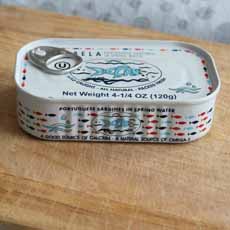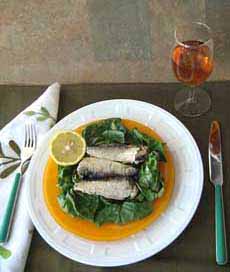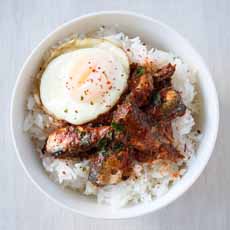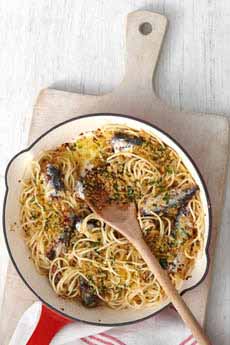|
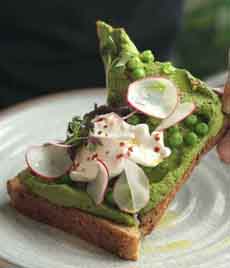
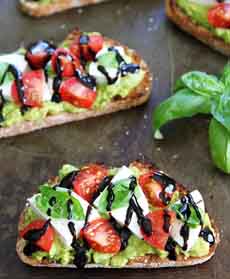

[1] Mashed avocado toast gives way to mashed green pea toast, called Smashed Pea Toast at Bluestone Lane, a group of Australian-inspired cafés in New York City, Hoboken and Philadelphia. [2] Served Caprese-style. Here’s the recipe from Two Peas And Their Pod. [3] Esquites-style: Mexican corn salad with cotija cheese, lime and cilantro. Here’s the recipe from Closet Cooking.
|
|
Avocado toast is an open-face sandwich, topping a piece of toast (often made with whole-grain or artisan bread) with mashed avocado seasoned with salt, pepper and lemon or lime juice.
The not-so-recent history of avocado toast is below.
More recently, mashed peas are being substituted for the avocado, along with more elaborate garnishes:
Beans: any beans, including chickpeas with a garnish of hummus, and black beans with salsa.
Cucumber slices: (plain or marinated) with fresh dill and cracked pepper.
Cheese: from crumbled feta and goat cheese to shaved parmesan.
Dried vegetables: beets, broccoli, caulifloer, corn, kale, plantain chips, wasabi peas.
Eggs: fried, hard-boiled/sliced, poached eggs.
Freeze-dried fruit and vegetables: such as Crunchies (see below).
Fresh fruit: berries and sliced fruits, including citrus segments.
Herbs and spices: from fresh basil, cilantro, dill, parsley, rosemary and thyme to chipotle, garlic, harissa and ras-el-hanout.
Lettuces: baby arugula (try it with goat cheese) or spinach, frisée, mesclun, watercress,
Onion family: chopped green onion, minced chives, sliced red onion.
Savory garnish: capers, edamame, green peas, jalapeño, microgreens, nuts and seeds, olives, pickled onions, radish slices, red chile flakes, sprouts.
Shellfish: crab, lobster, scallops, shrimp
Smoked fish: smoked salmon, with thin-sliced red onion and fresh dill.
Sweet garnish: citrus peel, crushed pineapple, honey-roasted nuts, pomegranate arils.
Tomato: halved cherry or grape tomatoes, plain or marinated (try them Caprese-style with bocconcini—small mozzarella balls—fresh basil and a balsamic glaze drizzle); sliced or diced tomato*, sundried tomato.
________________
*No decent tomatoes? Drain diced or whole canned San Marzano tomatoes.
________________
There are even sweet avocado toast options, such as:
A topping of sliced bananas (try caramelizing them in a hot skillet), with optional coconut
Chocolate-avocado toast (recipe follows).
Dried fruits (see Crunchies, below).
Shredded coconut.
For chocolate-avocado, mix 1/2 mashed avocado with one tablespoon of cocoa powder and 1-2 teaspoons of honey or maple syrup. Top with berries, coconut and/or mini chocolate chips.
RECIPE: MASHED PEA TOAST†
Ingredients For 6 Servings
1 garlic clove, quartered
1/4 cup fresh flat-leaf parsley leaves
3 tablespoons extra-virgin olive oil, divided, plus more for toast
Kosher salt
2 cups shelled fresh peas (from about 2 pounds pods) or frozen peas, thawed, plus more for garnish
2 tablespoons chopped fresh chives
1 tablespoon grated lemon peel, divided
1 tablespoon (or more) fresh lemon juice
1/4 teaspoon crushed red pepper flakes plus more for garnish
Freshly ground black pepper
6 pieces toast of choice
Garnish: sliced radishes, whole peas
|
|
Preparation
1. COMBINE the garlic, parsley, 1 tablespoon olive oil, a pinch of salt and 1/2 cup water in a small saucepan. Add the peas and cook over medium heat, stirring occasionally, until tender (about 5 minutes for fresh peas, 2 minutes for frozen peas). Drain, reserving the cooking liquid.
2. TRANSFER the pea mixture to a food processor; pulse to a coarse paste. Alternatively, for a chunkier blend, mash with a fork or a potato masher. Transfer to a medium bowl and mix in the chives, lemon juice and peel, pepper and 2 tablespoons olive oil.
3. STIR in the reserved cooking liquid, tablespoon by tablespoonful, until the mixture is still thick but spreadable. Season with salt, black pepper and more lemon juice, if desired.
4. TOP the toast with pea the mash peas. Garnish with the a sprinkle of whole peas, the remaining lemon peel, and more crushed pepper, as desired.
________________
*Adapted from a Bon Appetit recipe for mashed avocado sandwiches with preserved lemon.
|
|
CRUNCHY FUN WITH CRUNCHIES FREEZE-DRIED FRUIT SNACKS
We’ve long been fans of Crunchies freeze-fried fruits and vegetables: a healthful, low-calorie, crunchy, all natural grab-and-go snack with no added sugar.
In addition to grab and go snacking, we use them as garnishes for everything from salad to sorbet.
The fruits include blueberries, cinnamon apple, grapes, mango, mixed fruit, pineapple, raspberries, strawberries and strawberry banana.
Alas, our favorite freeze-dried corn kernels has been discontinued; but it’s been replaced by something equally wonderful: freeze dried sliced beets!
The line is certified gluten free, kosher (OU) and non-GMO.
You can find a store locator of buy online at CrunchiesFood.com.
|
|

Crunchies freeze-dried beet slices, one of 10 varieties from Crunchies Food.
|
THE HISTORY OF AVOCADO TOAST
Although a relatively new trend in the U.S. (we first noticed it about four years ago), avocado toast has been “commonplace for a long time,” according to Wikipedia.
In Australia and Chile, large avocado growers, people have been eating avocado toast for decades.
In the U.K., it has been a popular snack since the early-1970s.
In Mexico, where the avocado is indigenous (the history of avocado), avocado on corn tortillas dates to ancient times.
Surely, some conquistador, or more likely one of the nuns who followed in the early 16th century (the nuns created fusion European-Aztec cuisine, adapting New World ingredients to Old World cooking styles), first put sliced avocado on a piece of toasted European bread. But the record is mute on that.
According to an article in The Washington Post, chef Bill Granger of Sydney, Australia may have been the first person to put avocado toast on a menu, in 1993. Another Australian chef believes that the combination of avocado and toast emerged in Queensland, Australia in the mid-1970s.
Now, Millennials call it “smashed avo.”
In 1999, Nigel Slater published a recipe for an avocado “bruschetta” in London’s newspaper, The Guardian.
Even earlier, in 1962, a New York Times article showcased an “unusual” sandwich of avocado on toast.
And even earlier than that, in 1937, The New Yorker published an article, “Avocado, or the Future of Eating,” in which the protagonist eats “avocado sandwich on whole wheat and a lime rickey.” [source]
But credit social media with launching this low-key breakfast and snack into stardom, with an endless number of photos making it a must-have for avocado lovers.
|
|















